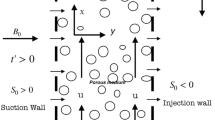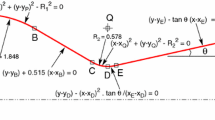Abstract
A numerical algorithm and code are developed and applied to direct numerical simulation (DNS) of unsteady two-dimensional flow fields relevant to stability of the hypersonic boundary layer. An implicit second-order finite-volume technique is used for solving the compressible Navier–Stokes equations. Numerical simulation of disturbances generated by a periodic suction-blowing on a flat plate is performed at free-stream Mach number 6. For small forcing amplitudes, the second-mode growth rates predicted by DNS agree well with the growth rates resulted from the linear stability theory (LST) including nonparallel effects. This shows that numerical method allows for simulation of unstable processes despite its dissipative features. Calculations at large forcing amplitudes illustrate nonlinear dynamics of the disturbance flow field. DNS predicts a nonlinear saturation of fundamental harmonic and rapid growth of higher harmonics. These results are consistent with the experimental data of Stetson and Kimmel obtained on a sharp cone at the free-stream Mach number 8.
Similar content being viewed by others
References
Lin, T.C., Grabowsky, W.R., Yelmgren, K.E.: The search for optimum configurations for re-entry vehicles. J. Spacecraft Rockets 21(2), 142–149 (1984)
Tartabini, P.V., Lepsch, R.A., Korte, J.J., Wurster, K.E.: A multidisciplinary performance analysis of a lifting-body single-stage-to-orbit vehicle. AIAA Paper No. 2000-1045 (2000)
Reed, H.L., Kimmel, R., Schneider, S., Arnal, D.: Drag prediction and transition in hypersonic flow. AIAA Paper No. 97-1818 (1997)
Malik, M.R.: Boundary-layer transition prediction Toolkit. AIAA Paper No. 97-1904 (1997)
Morkovin, M.: Bypass transition to turbulence and research desiderata. Transition in turbulence. NASA CP-2386, 161–199 (1985)
Jaffe, N.A., Okamura, T.T., Smith, A.M.O.: Determination of spatial amplification factors and their application to predicting transition. AIAA J. 8, 301–308 (1970)
Chang, C.-L., Malik, M.R.: Compressible stability of growing boundary layers using parabolized stability equations. AIAA Paper No. 91-1636 (1991)
Pruett, C.D., Chang, C.-L.: Spatial direct numerical simulation of high-speed boundary layer flows. Part II: Transition on a cone in Mach 8 flow. Theor. Comput. Fluid Dyn. 7, 397–424 (1995)
Balakumar, P., Zhao, H., Atkins, H.: Stability of hypersonic boundary-layer over a compression corner. AIAA Paper No. 2002-2848 (2002)
Atkins, H.L.: High-order ENO method for the unsteady compressible Navier-Stokes equations. AIAA Paper No. 91-1557 (1991)
Zhong, X.: Direct numerical simulation of hypersonic boundary-layer transition over blunt leading edges. Part I: A new numerical method and validation. AIAA Paper No. 97-0755 (1997)
Hu, S.H., Zhong, X.: Linear stability of hypersonic flow over a parabolic leading edge. AIAA Paper No. 97-2015 (1997)
Zhong, X.: Receptivity of hypersonic boundary layers to freestream disturbances. AIAA Paper No. 2000-0531 (2000)
Ma, Y., Zhong, X.: Direct numerical simulation of instability of nonequilibrium reacting hypersonic boundary layers. AIAA Paper No. 2000-0539 (2000)
Ma, Y., Zhong, X.: Direct numerical simulation of receptivity and stability of nonequilibrium reacting hypersonic boundary layers. AIAA Paper No. 2001-0892 (2001)
Zhong, X., Ma, Y.: Receptivity and linear stability of stetson's Mach 8 blunt cone stability experiments. AIAA Paper No. 2002-2849 (2002)
Stetson, K.F., Thompson, E.R., Donaldson, J.C., Siler, L.G.: Laminar boundary layer stability experiments on a cone at mach 8. Part 2: Blunt cone. AIAA Paper No. 84-0006 (1984)
Stetson, K.F., Kimmel, R.L.: On hypersonic boundary layer stability. AIAA Paper No. 92-0737 (1992)
Godunov, S.E.: A finite difference method for the computation of discontinuous solutions of the equations of fluid dynamics. Math. Sb. 47(3), 271–306 (1959)
Roe, P.L.: Approximate riemann solvers, parameter vectors, and difference scheme. J. Comput. Phys. 43, 357–372 (1981)
Kolgan, V.P.: The application of minimum derivatives principe to the construction of finite difference schemes to calculate discontinuous solutions of gasdynamics. Uchen. Zap. TsAGI 3(6), 68–77 (1972)
van Leer, B.: Towards the ultimate conservative difference scheme. III. Upstream-centered finite-difference schemes for ideal compressible flow. J. Comput. Phys. 23(3), 263–275 (1977)
Ortega, J.M., Rheinboldt, W.C.: Iterative solution of nonlinear equations in several variables. Academic Press, New York and London (1970)
Egorov, I.V., Ivanov, D.V.: Application of Newton's method in simulation of unsteady separated flows. Comput. Math. Math. Phys. 38(3), 488–492 (1998)
Babaev, I.Yu., Bashkin, V.A., Egorov, I.V.: Numerical solution of Navier–Stokes equations by using iteration variation-type methods. J. Comput. Math. Math. Phys. 34(11), 1693–1703 (1994)
Bashkin, V.A., Egorov, I.V., Ivanov, D.V.: The application of the newton method to simulate inner supersonic separated flows. Prikl. Mekh. i Tekh. Fiz. 1, 30–42 (1997)
Mack, L.M.: Linear stability theory and the problem of supersonic boundary layer transition. AIAA J. 13, 278–289 (1975)
Guschin, V.R., Fedorov, A.V.: Short-wave instability in a perfect-gas shock layer. Fluid Dyn. 24(1), 7–10 (1989)
Fedorov, A.V., Khokhlov, A.P.: Prehistory of instability in a hypersonic boundary layer. Theoret. Comput. Fluid Dyn. 14(6), 359–375 (2001)
Fedorov, A.V., Khokhlov, A.P.: Receptivity of hypersonic boundary layer to wall disturbances. Theoret. Comput. Fluid Dyn. 15(4), 231–254 (2002)
Stetson, K.F., Kimmel, R.L.: On the breakdown of a hypersonic laminar boundary layer. AIAA Paper No. 93-0896 (1993)
Pruett, C.D., Zang, T.A.: Direct numerical simulation of laminar breakdown in high-speed, axisymmetric boundary layers. AIAA Paper No. 92-0742 (1992)
Ma, Y., Zhong, X.: Receptivity of a supersonic boundary layer over a flat plate. Part 2: Receptivity to free-stream sound. J. Fluid. Mech. 488, 79–121 (2003).
Shiplyuk, A.N., Bountin, D.A., Maslov, A.A., Chokani, N.D.: Nonlinear interactions of second mode instability with natural and artificial disturbances. AIAA Paper No. 2003-0787 (2003)
Author information
Authors and Affiliations
Corresponding author
Additional information
Communicated by M.Y. Hussaini
Rights and permissions
About this article
Cite this article
Egorov, I.V., Fedorov, A.V. & Soudakov, V.G. Direct numerical simulation of disturbances generated by periodic suction-blowing in a hypersonic boundary layer. Theor. Comput. Fluid Dyn. 20, 41–54 (2006). https://doi.org/10.1007/s00162-005-0001-y
Received:
Accepted:
Published:
Issue Date:
DOI: https://doi.org/10.1007/s00162-005-0001-y




